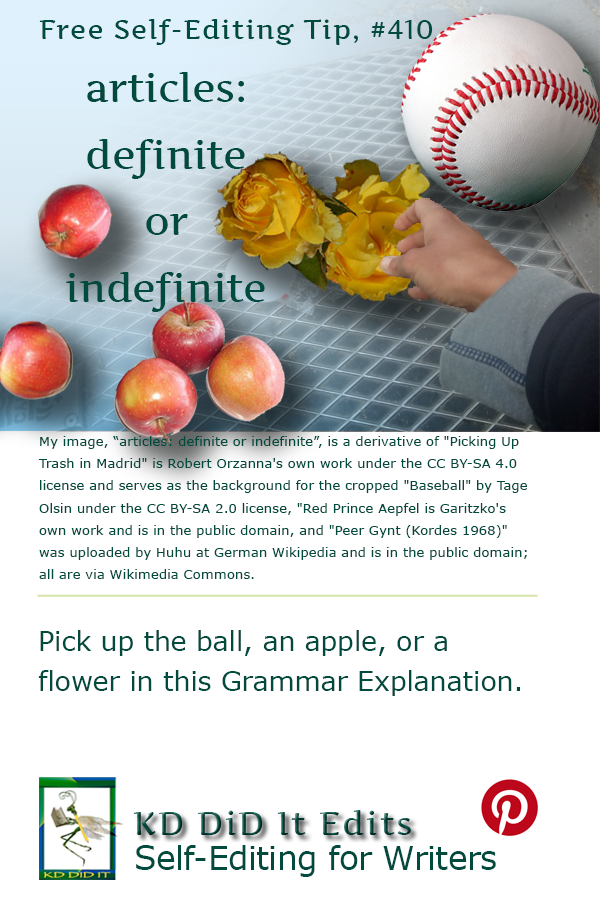Revised as of
7 Oct 2022
This post explores the versus a / an, and doesn’t delve too much into the differences between a and an. For more on the latter, read the post, “A versus An“.
Do be aware that both definite and indefinite articles are grouped under determiners.
Grammar Explanations is . . .
. . . an evolving list of the structural rules and principles that determines where words are placed in phrases or sentences as well as how the language is spoken. Sometimes I run across an example that helps explain better or another “also known as”. Heck, there’s always a better way to explain it, so if it makes quicker and/or better sense, I would appreciate suggestions and comments from anyone . . . Are there areas of grammar with which you struggle? If you’d like to track it, bookmark this page and consider sharing this Grammar Explanation with friends by tweeting it.
| Article – a, an, the | ||
| Definite Article – the | Indefinite Article – a, an | |
|---|---|---|
| Definition: The refers to specific or particular nouns. | Definition: A and an modifies non-specific or non-particular nouns. | |
| The table is brown.
The apple is red. |
A table is brown.
An apple is red. |
|
| a | ||
| Rule: The form used before words beginning with a consonant sound. Explore the post, “A versus An“, for more detail on the difference between a and an. | ||
| The man came out of the room.
Gimme the hundred. I can’t find the dress anywhere. He is the lawyer. This car is the BMW. It cost as much as eight dollars the dozen. The judge telephoned. You’re no better than the rest. Is this the book you gave me? Come into the house. |
A man came out of the room.
Gimme a hundred. I simply haven’t a dress to wear. He is a lawyer. This car is a BMW. It cost as much as eight dollars a dozen. A judge telephoned. You’re no better than a Hitler. It has been a joy to have you. We need people with a knowledge of languages. It should only take a quarter of an hour. She was typing 60 words a minute. |
|
| Rule: Used to mark a proper noun, natural phenomenon, ship, building, time, point of the compass, branch of endeavor, or field of study as something well-known or unique. | ||
| She’s heading into the sun.
It’s the Alps for the best skiing and mountaineering, you know. Look to the past for your answers. The elves are going into the West. Have you been to the Eiffel Tower yet? |
an | |
| Rule: The form used before words beginning with a vowel sound. Explore the post, “A versus An“, for more detail on the difference between a and an. | ||
| Rule: Used with or as part of a title. | An ant came out of its hole.
It has been an honor to have you. We need an idiot with no knowledge of languages. You’re no better than an imbecile. He is an editor. This car is an Audi. A Civil Contract is an historical romance by Georgette Heyer. |
|
| He’s the Duke of Wellington.
The Reverend John Smith has come to call. Her Majesty, the Queen Elizabeth, has requested your company. |
||
| Rule: Used to mark a noun as indicating the best-known, most approved, most important, most satisfying, etc. | ||
| If you want powder, Kirkwood is the skiing center of the U.S.
If you’re going to work hard, now is the time. |
||
| Rule: Used to mark a noun as being used generically. | ||
| The dog is a quadruped.
The balls are all deflated. |
||
| Rule: Used in place of a possessive pronoun, to note a part of the body or a personal belonging. | ||
| He won’t be able to play football until the leg mends. | ||
| Rule: Used before adjectives that are used substantively, to note an individual, a class or number of individuals, or an abstract idea. | ||
| He actually likes to visit the sick.
It went from the sublime to the ridiculous. |
||
| History of the Word: | ||
| Old English Northumbrian and North Mercian dialects thē is related to the Dutch de, dat and the German der, die, and das. | Middle English as a weak form of ān meaning one. | |
C’mon, get it out of your system, bitch, whine, moan . . . which words are your pet peeves? Also, please note that I try to be as accurate as I can, but mistakes happen or I miss something. Email me if you find errors, so I can fix them . . . and we’ll all benefit!
Satisfy your curiosity about other Grammar Explanations by exploring its homepage or more generally explore the index of self-editing posts. You may also want to explore Book Layout & Formatting Ideas, Formatting Tips, Grammar Explanations, Linguistics, Publishing Tips, the Properly Punctuated, Word Confusions, Writing Ideas and Resources, and Working Your Website.
Resources for Article
The Purdue Writing Lab. Purdue OWL. n.d. Web. n.d. <http://owl.english.purdue.edu/owl/resource/540/01/>.
Pinterest Photo Credits:
Picking Up Trash in Madrid is Robert Orzanna’s own work under the CC BY-SA 4.0 license and serves as the background for the cropped “Baseball” by Tage Olsin under the CC BY-SA 2.0 license, “Red Prince Aepfel is Garitzko’s own work and is in the public domain, and “Peer Gynt (Kordes 1968)” was uploaded by Huhu at German Wikipedia and is in the public domain; all are via Wikimedia Commons.


